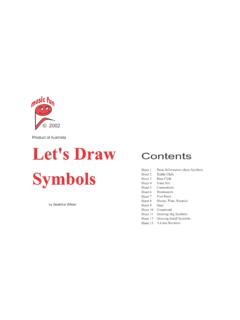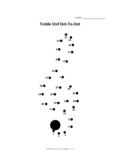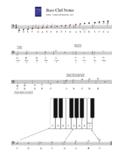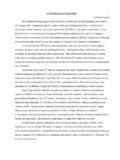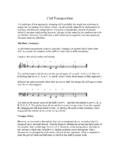Transcription of Why the missing pages? This is a FREE preview book with 18 ...
1 Why the missing pages ? this is a FREE preview book with 18 topics covering music theory fundamentals. The full print edition has 19 bonus topics and a complete index. As a fellow musician, I want to offer you this free, useful book. Please GIVE this FREE EDITION AWAY to everyone you know! Post it online, email it, give it to your students, whatever! You can buy the full book at I try to keep the price low to help you out, and bulk discounts are available at checkout. Please don t copy or share the bonus topics from the print edition. I put many, many, many hours of work into this book, so please respect the livelihood of a fellow musician. Thanks for your help! Copyright 2011 by Mark Feezell.
2 All Rights Reserved. Visit for the latest editions and more great theory materials. Music Theory Fundamentals High-Yield Music Theory, vol. 1 Mark Feezell iii TA B L E O F CO N T E N T S Foreword: What is high-yield music theory?..v!Chapter 1: Music ! Staves and ! The Chromatic Scale and the ! All About ! Rhythmic ! Time Signatures in Simple ! Compound and Asymmetric ! ! Repeat Signs and Repeated ! Dynamics, Articulations, Slurs, Tempo ! Summary of Notation !Chapter 2: Major and Minor Scales and ! Major ! The Circle of ! Learning Major Key ! Minor Scales: Two ! Key Signatures Self-Study ! Scale Degree ! Major and Natural Minor Scales for !
3 Chapter 3: Intervals and ! Introduction to ! Mastering Intervals ! Mastering Intervals ! !Chapter 4: Triads and Seventh ! Introducing ! The Major Triads: Spell Them ! Spelling Triads in Four ! Seventh ! Common Chord Reference ! Basic Lead Sheet !Chapter 5: Introduction to Harmonic ! Texture in ! Roman ! Harmonic ! Harmonic Analysis 1: Homophonic ! Nonchord Tones ! Nonchord Tones 2: ! Second Inversion ! Harmonic Analysis 2: Polyphonic !Appendices: Solf ge and Rhythmic !Appendix 1: Solf ge !Appendix 2: Rhythmic Counting !Postlude: Review, Resources, !Remember-Forever Review: Music Theory !Music Theory Fundamentals: More ! v Foreword: WH A T I S H I G H-Y I E L D M U S I C T H E O R Y?
4 The core principles guiding high-yield music theory are: 1. Assume no prior knowledge. 2. Build one concept at a time. 3. Get to the POINT! The latest editions of this study reference are available at Eventually there will be multiple volumes, covering Music Theory Fundamentals; Harmony; Jazz, Pop, and Contemporary Music Theory (including Twentieth-Century Music); and Form in Music. The format for each volume is consistent: 1. The left column lists terms to help you organize your study and find topics quickly. 2. Bold indicates key concepts. 3. Each volume ends with a Remember-Forever Review and More Resources. Students ..read it before or after your primary text for a music theory course.
5 Use it as an efficient review before entrance exams, barriers, etc..use it as a theory reference book by looking up terms in the index..use it to quiz or tutor your fellow students..check out the great resources listed under More Resources. Teachers ..use it as a class lecture outline along with your favorite theory text..use it as a review guide after presenting the material with your favorite text..use the Remember-Forever Review section before final exams..require students to purchase one or more volumes for extra study..use it as a primary textbook alongside your favorite workbook or music Volumes Format Students: how to use this guide Teachers: how to use this guide Chapter 1 MU S I C NO T A T I O N Staves and Clefs: elements of music, staff, note names, clef , treble clef , bass clef , ledger lines, grand staff, C clefs, alto clef , tenor clef The Chromatic Scale and the Piano: piano keyboard diagram, pattern of piano keyboard, half step, accidentals, whole step, natural half steps, enharmonic notes, scale, chromatic scale All About Octaves.
6 Octave, middle C, ledger lines between the staves, American Standard octave designations, Helmholtz octave designations, ottava, quindicesima, octave clef Rhythmic Values: duration, rhythmic value, rhythm, notehead, stems, flags, beams, rests, ties, augmentation dots, double-dotted notes Time Signatures in Simple Meter: beat, measure, bar, barline, time signature, beat unit, simple time signature, duple, triple, quadruple, beat division and subdivision, cut time, alla breve, common time, anacrusis, downbeat, strong beat, weak beat, stress patterns Compound and Asymmetric Meter: compound time signatures, tempo and meter, asymmetric time signatures, anacrusis and stress patterns in compound meter, summary of time signatures Tuplets/Grouplets: tuplets, grouplets, triplets, quintuplets, sextuplets, septuplets, brackets, duplets and quadruplets (compound time signatures), duplets and quadruplets as dotted values Repeat Signs and Repeated Sections: simple repeats, first and second endings, al fine, al coda, al fine, al coda, repeated beat, repeated measure, two-measure repeat Dynamics, Articulations, Slurs, Tempo Markings.
7 Dynamics, articulations, slurs, bowings, fermatas, breath marks, caesura/grand pause, crescendo, diminuendo, decrescendo, tempo, BPM, , Italian tempo indications Summary of Notation Guidelines: staves, system, clefs, noteheads, accidentals, stems, beams, rhythm and meter, key signatures High-Yield Music Theory, Vol. 1: Music Theory Fundamentals 8 Section ST A V E S A N D CLEFS The fundamental elements of music are pitch (the highness/lowness of the notes), duration (how long the notes last), timbre (overall type of sound such as trumpet versus clarinet), and dynamics/loudness. Some authors add frequency (the speed of the physical vibration making the sound) and texture (see Texture in Music).
8 A staff (plural: staves) uses five parallel lines to notate (write down) the pitch aspect of music. Higher-pitched notes are written higher on the staff. Staff lines are numbered 1 to 5, starting from the bottom line. Note names from low to high are the letters A, B, C, D, E, F, G, then repeating A, B, A clef indicates which note names go on which lines (and spaces between the lines) on the staff. Clefs are written at the start of the staff. Treble clef designates the second line from the bottom as G. The lines in treble clef represent the pitches E, G, B, D, and F. The spaces are F, A, C, and E. bass clef designates the fourth line from the bottom as F.
9 The lines in bass clef represent the pitches G, B, D, F, and A. The spaces are A, C, E, and G. &G, clefDEFGABCDEFG line 1line 5&Elines:Every Good Boy Does FineGBDF spaces:&DF-A-C-E spells faceFACEG wwwwwwwwwwwwwwwwwwwwwww?F, clefFGABCDEFGAB?Glines:Good Boys Do Fine AlwaysBDFA spaces:?FAll Cars Eat GasAll Cows Eat GrassACEGB wwwwwwwwwwwwwwwwwwwwwwwElements of music Staff Note names clef Treble clef bass clef Chapter 1: Music Notation 9 Ledger lines are small lines that extend the staff higher and lower. They can be used with any clef . Ledger lines belong to a single note; they never connect to ledger lines for surrounding notes. A grand staff is a treble clef staff and bass clef staff connected with a brace.
10 Piano music uses a grand staff, along with instruments such as harp and marimba. Sometimes vocal (choir) music is also notated using a grand staff. All C clefs indicate where C is on the staff. Alto clef is a C clef centered on the third line from the bottom, designating it as C. Parts for the viola (a string instrument in the violin family) almost always use alto clef . Tenor clef is a C clef centered on the fourth line from the bottom, designating it as C. Bassoon and trombone music occasionally uses tenor clef , although both instruments more commonly read bass clef . &ACBBACGD ledger lines?CEDDCEBF wwwwwwwwwwwwwwww&EbraceGBDFDFACEG?Ggrand staffBDFAFACEGB wwwwwwwwwwwwwwwwwwwwwwBC, clefEFGABCDEFGA wwwwwwwwwwwwBC, clefCDEFGABCDEF wwwwwwwwwwwwLedger lines Grand staff C clefs Alto clef Tenor clef High-Yield Music Theory, Vol.




